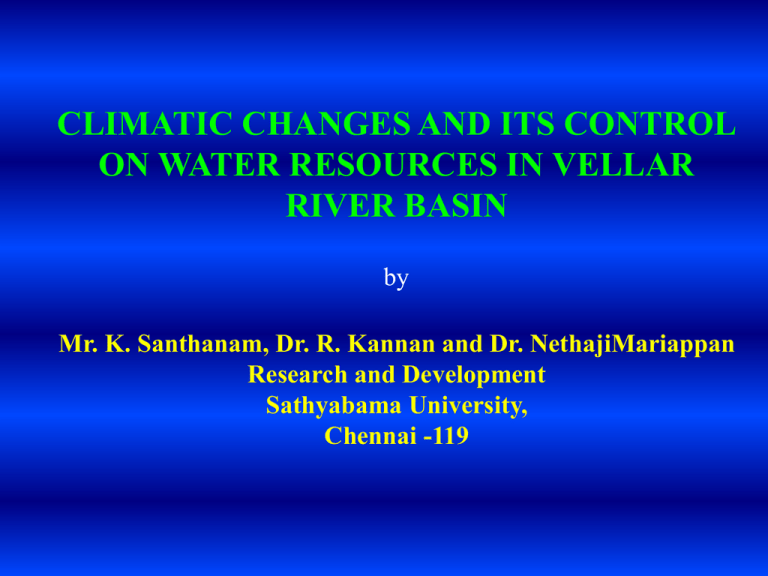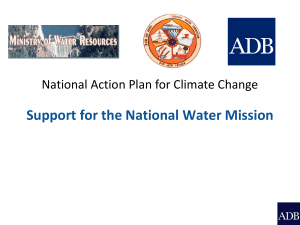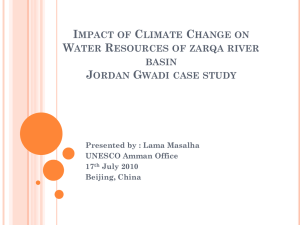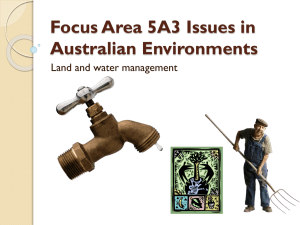Vellar Climate
advertisement

CLIMATIC CHANGES AND ITS CONTROL ON WATER RESOURCES IN VELLAR RIVER BASIN by Mr. K. Santhanam, Dr. R. Kannan and Dr. NethajiMariappan Research and Development Sathyabama University, Chennai -119 Vellar River Basin One of the 17 major river basins of Tamil Nadu Index map showing Vellar Basin • Administrative boundaries :Dharmapuri, Salem, Viluppuram, Cuddalore, Namakkal, Perambalure and Tiruchi Districts • Total Geographical area :7521 sq. km • Physiography :Kalvanrayan Hills in north and KollimalaiPachchamalai hills in the south • Regions :Western hilly terrain Central Hill valley complex terrain Eastern deltaic plain and coastal region Administrative and Sub basin boundary map Drainage Map of Vellar basin Tributaries -Vasista Nadhi -Swetha Nadhi -Chennar River -Anaivari Oodai -Manimutha Nadhi -Gomukhi Nadhi -Periya Ooadi Vellar River basin drainage Map RELIEF MAP Maximum Elevation : 1266 m (Kalvarayan Hills-South slope) Ranges of Elevation : 110 m to 1183 m In the northwestern part of Vellar Basin Minimum elevation :20 to 40 m (Chidambaram) Relief map of Vellar basin GEOLOGY Western part of the basin – Archean Group of rocks ( Magnetite Quartzite, charnockite, Granulite and Amphibolite) Eastern part - Sedimentary formations of Cretaceous Argillaceous sand stone Calcareous sand stone Shale and Lime stone Tertiary sand stone , lignite, clay and shale Quaternary Beach, sand dunes, black clay, flood plians and alluvium Vellar River Basin Geology Map Vellar River Basin satellite image mosaic Vellar River basin Geomorphology Map Vellar River basin Southeast monsoon Rainfall Vellar River basin Northwest monsoon Rainfall A NNUA L RF IN mm 5 Y EA RS MOV . A V E. A NNUA L A V G. Ye a r Linear ( A NNUA L RF IN mm) 2002- 03 2001- 02 2000- 01 1999- 00 1998- 99 1997- 98 1996- 97 1995- 96 1994- 95 1993- 94 1992- 93 1991- 92 1990- 91 1989- 90 1988- 89 1987- 88 1986- 87 1985- 86 1984- 85 1983- 84 1982- 83 1981- 82 1980- 81 1979- 80 1978- 79 1977- 78 1976- 77 1975- 76 1974- 75 1973- 74 A NNUA L A V G. 1972- 73 1971- 72 5 Y EA RS MOV . A V E. A N N U A L R F in m m A NNUA L RF IN mm 2002- 03 2001- 02 2000- 01 1999- 00 1998- 99 1997- 98 1996- 97 1995- 96 1994- 95 1993- 94 1992- 93 1991- 92 1990- 91 1989- 90 1988- 89 1987- 88 1986- 87 1985- 86 1984- 85 1983- 84 1982- 83 1981- 82 1980- 81 1979- 80 1978- 79 1977- 78 1976- 77 1975- 76 1974- 75 1973- 74 1972- 73 1971- 72 A N N U A L R F in m m R A S IP U R A M 1600.0 1400.0 1200.0 1000.0 800.0 600.0 400.0 200.0 0.0 Ye a r Linear ( A NNUA L RF IN mm) S E N D AM AN GAL AM 1400.0 1200.0 1000.0 800.0 600.0 400.0 200.0 0.0 A NNUA L RF IN mm 5 Y EA RS MOV . A V E. A NNUA L A V G. 2003- 04 2002- 03 2001- 02 2000- 01 1999- 00 1998- 99 1997- 98 1996- 97 1995- 96 1994- 95 1993- 94 1992- 93 1991- 92 1990- 91 1989- 90 1988- 89 1987- 88 1986- 87 1985- 86 1984- 85 1983- 84 1982- 83 1981- 82 1980- 81 1979- 80 1978- 79 1977- 78 1976- 77 1975- 76 1974- 75 1973- 74 A NNUA L A V G. 1972- 73 1971- 72 5 Y EA RS MOV . A V E. A N N U A L R F in m m A NNUA L RF IN mm 2003- 04 2002- 03 2001- 02 2000- 01 1999- 00 1998- 99 1997- 98 1996- 97 1995- 96 1994- 95 1993- 94 1992- 93 1991- 92 1990- 91 1989- 90 1988- 89 1987- 88 1986- 87 1985- 86 1984- 85 1983- 84 1982- 83 1981- 82 1980- 81 1979- 80 1978- 79 1977- 78 1976- 77 1975- 76 1974- 75 1973- 74 1972- 73 1971- 72 A N N U A L R F in m m AT H U R 2500.0 2000.0 1500.0 1000.0 500.0 0.0 Ye a r Linear ( A NNUA L RF IN mm) 3000.0 C H ID A M B A R A M 2500.0 2000.0 1500.0 1000.0 500.0 0.0 Ye a r Linear ( A NNUA L RF IN mm) TECHNICAL CONCLUSIONS Western part of Vellar river basin receives more rainfall during south west monsoon Due to elevation (1300 m) and Compactness of hard rock, surface water goes as runoff to the eastern sedimentary formation Due to compactness recharge is not possible in the western and central portions as geological conditions and geomorphological conditions are not favourable Year by year rainfall quantity is decreasing TECHNICAL CONCLUSIONS In the eastern part Northeast monsoon rainfall is predominant In addition to south west monsoon rainfall, water from western part is also recharging the sedimentary aquifer Hence Aquifer is fully saturated in south west monsoon During North East monsoon rainfall water goes as surplus water to sea and heavy flood is caused in Chidambaram and Cuddalore Taluks RECOMMENDATIONS In the upstream side of western part of the river basin more artificial recharge structures like check dams percolation ponds, recharge pits have to be constructed in order to retain water in upstream side so that south west monsoon water will not go to down stream side. In Eastern side water level may be lowered for irrigation purposes so that Northeast monsoon rain water will reach the aquifer and gets recharged By these procedures the surplus water running to the sea can be prevented. Heavy water logging in the coastal region can be avoided








